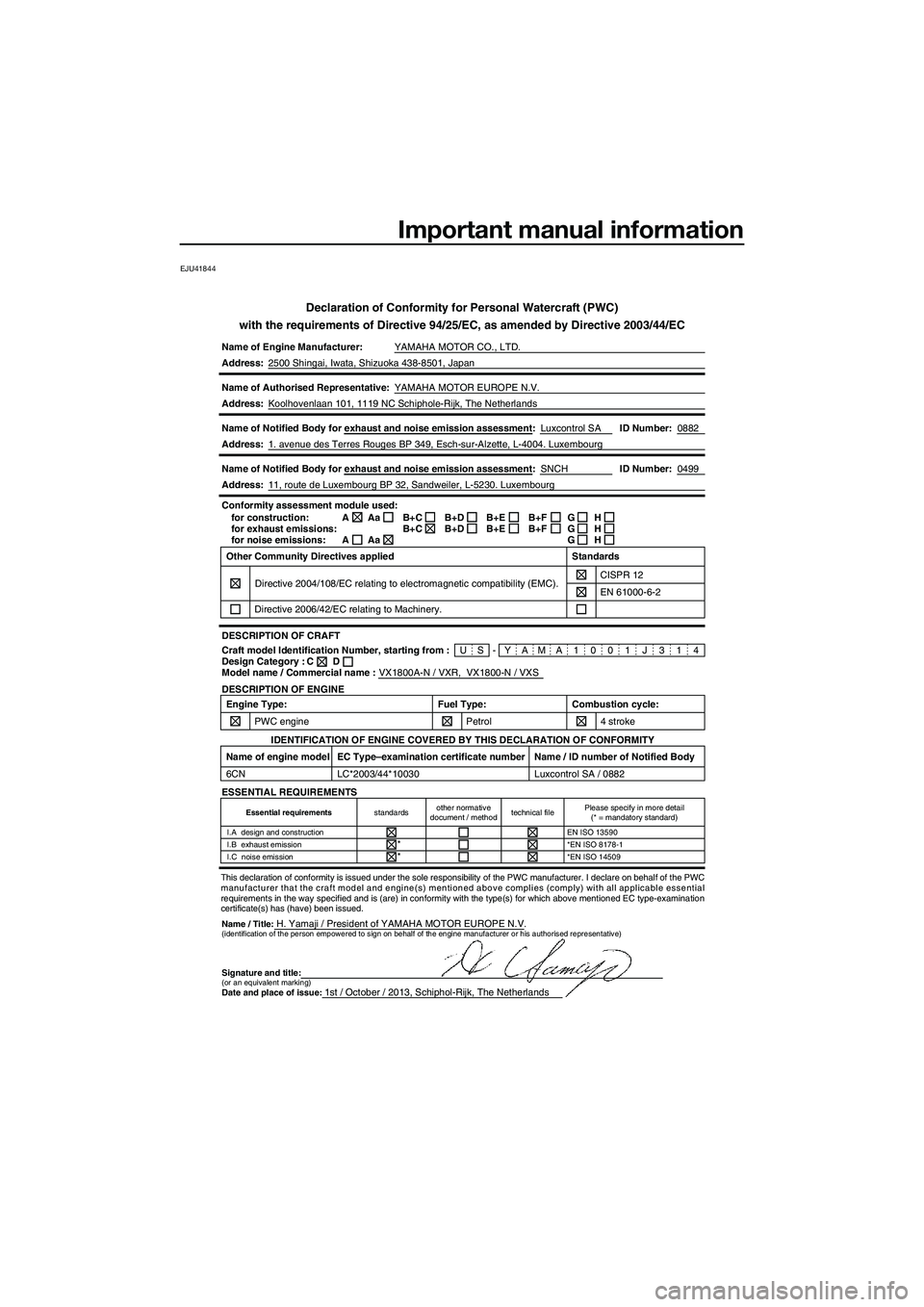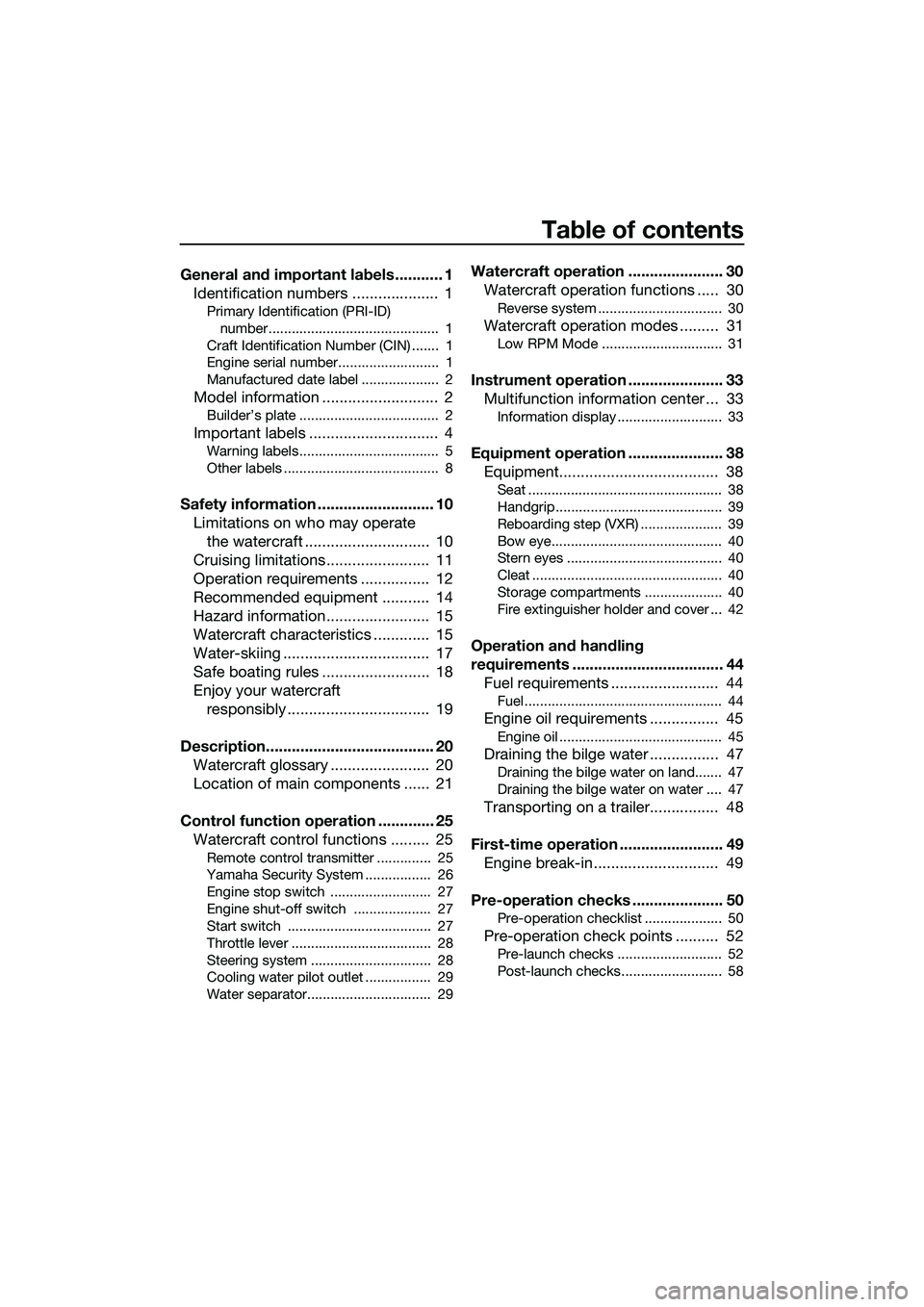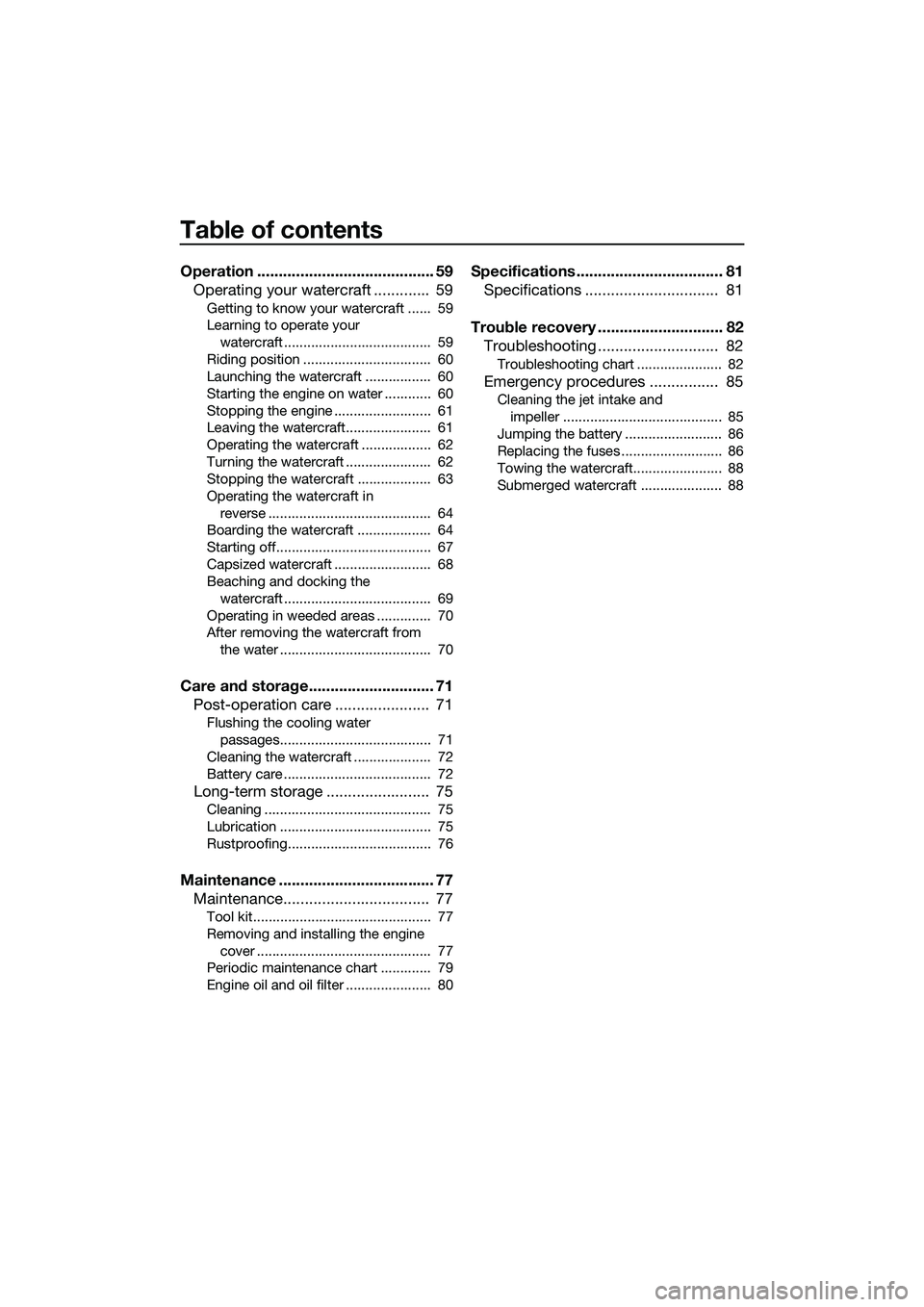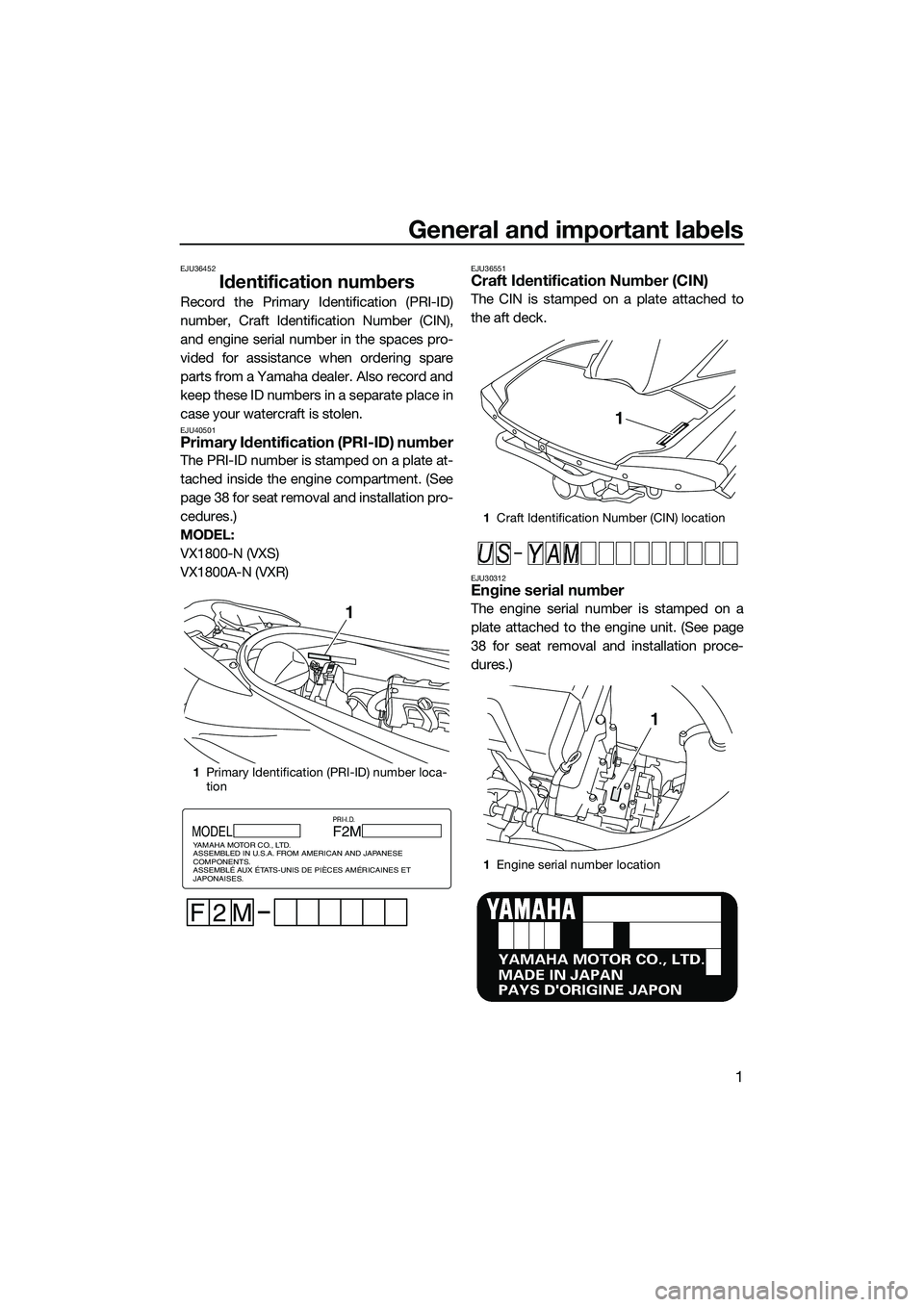engine YAMAHA VXR 2014 Owners Manual
[x] Cancel search | Manufacturer: YAMAHA, Model Year: 2014, Model line: VXR, Model: YAMAHA VXR 2014Pages: 98, PDF Size: 3.98 MB
Page 3 of 98

Important manual information
EJU41844
Declaration of Conformity for Personal Watercraft (PWC)
with the requirements of Directive 94/25/EC, as amended by Directive 200\
3/44/EC
Name of Engine Manufacturer: YAMAHA MOTOR CO., LTD.
Name / Title:H. Yamaji / President of YAMAHA MOTOR EUROPE N.V.
Address:
2500 Shingai, Iwata, Shizuoka 438-8501, Japan
Name of Authorised Representative: YAMAHA MOTOR EUROPE N.V.
Address: Koolhovenlaan 101, 1119 NC Schiphole-Rijk, The Netherlands
Name of Notified Body for exhaust and noise emission assessment: Luxcontrol SA
Address: 1. avenue des Terres Rouges BP 349, Esch-sur-Alzette, L-4004. Luxembourg\
Name of Notified Body for exhaust and noise emission assessment: SNCH
VX1800A-N / VXR, VX1800-N / VXS 0882
0499
Address: 11, route de Luxembourg BP 32, Sandweiler, L-5230. Luxembourg
US-YAMA1001J314
Conformity assessment module used:
for construction:
for exhaust emissions:
for noise emissions:
DESCRIPTION OF CRAFT
DESCRIPTION OF ENGINE A
A
Craft model Identification Number, starting from :
Model name / Commercial name : C
Design Category : Other Community Directives applied
Directive 2004/108/EC relating to electromagnetic compatibility (EMC).\
CISPR 12
Directive 2006/42/EC relating to Machinery. Standards
EN 61000-6-2
D
Aa
AaB+C
B+CB+D
B+D B+E
B+EB+F
B+FG
G
GH
H
H
Engine Type:
PWC engine Combustion cycle:
4 stroke
Fuel Type:
Petrol
ESSENTIAL REQUIREMENTS
IDENTIFICATION OF ENGINE COVERED BY THIS DECLARATION OF CONFORMITY
Name of engine model
6CN Name / ID number of Notified Body
Luxcontrol SA / 0882
EC Type–examination certificate number
LC*2003/44*10030
(identification of the person empowered to sign on behalf of the engine\
manufacturer or his authorised representative)
Signature and title:(or an equivalent marking)Date and place of issue:1st / October / 2013, Schiphol-Rijk, The Netherlands
Essential requirements
standardsother normative
document / method technical filePlease specify in more detail
(* = mandatory standard)
I.A design and construction EN ISO 13590
I.B exhaust emission *EN ISO 8178-1
I.C noise emission *EN ISO 14509
*
*
This declaration of conformity is issued under the sole responsibility o\
f the PWC manufacturer. I declare on behalf of the PWC
manufacturer that the craft model and engine(s) mentioned above compli\
es (comply) with all applicable essential
requirements in the way specified and is (are) in conformity with the \
type(s) for which above mentioned EC type-examination
certificate(s) has (have) been issued.
ID Number:
ID Number:
UF2M73E0.book Page 1 Friday, August 2, 2013 11:28 AM
Page 5 of 98

Table of contents
General and important labels ........... 1Identification numbers .................... 1
Primary Identification (PRI-ID)
number............................................ 1
Craft Identification Number (CIN) ....... 1
Engine serial number.......................... 1
Manufactured date label .................... 2
Model information ........................... 2
Builder’s plate .................................... 2
Important labels .............................. 4
Warning labels.................................... 5
Other labels ........................................ 8
Safety information ........................... 10 Limitations on who may operate the watercraft ............................. 10
Cruising limitations ........................ 11
Operation requirements ................ 12
Recommended equipment ........... 14
Hazard information........................ 15
Watercraft characteristics ............. 15
Water-skiing .................................. 17
Safe boating rules ......................... 18
Enjoy your watercraft responsibly ................................. 19
Description....................................... 20 Watercraft glossary ....................... 20
Location of main components ...... 21
Control function operation ............. 25 Watercraft control functions ......... 25
Remote control transmitter .............. 25
Yamaha Security System ................. 26
Engine stop switch .......................... 27
Engine shut-off switch .................... 27
Start switch ..................................... 27
Throttle lever .................................... 28
Steering system ............................... 28
Cooling water pilot outlet ................. 29
Water separator................................ 29
Watercraft operation ...................... 30Watercraft operation functions ..... 30
Reverse system ................................ 30
Watercraft operation modes ......... 31
Low RPM Mode ............................... 31
Instrument operation ...................... 33Multifunction information center ... 33
Information display ........................... 33
Equipment operation ...................... 38Equipment..................................... 38
Seat .................................................. 38
Handgrip........................................... 39
Reboarding step (VXR) ..................... 39
Bow eye............................................ 40
Stern eyes ........................................ 40
Cleat ................................................. 40
Storage compartments .................... 40
Fire extinguisher holder and cover ... 42
Operation and handling
requirements ................................... 44Fuel requirements ......................... 44
Fuel................................................... 44
Engine oil requirements ................ 45
Engine oil .......................................... 45
Draining the bilge water ................ 47
Draining the bilge water on land....... 47
Draining the bilge water on water .... 47
Transporting on a trailer................ 48
First-time operation ........................ 49 Engine break-in............................. 49
Pre-operation checks ..................... 50
Pre-operation checklist .................... 50
Pre-operation check points .......... 52
Pre-launch checks ........................... 52
Post-launch checks.......................... 58
UF2M73E0.book Page 1 Friday, August 2, 2013 11:28 AM
Page 6 of 98

Table of contents
Operation ......................................... 59Operating your watercraft ............. 59
Getting to know your watercraft ...... 59
Learning to operate your
watercraft ...................................... 59
Riding position ................................. 60
Launching the watercraft ................. 60
Starting the engine on water ............ 60
Stopping the engine ......................... 61
Leaving the watercraft...................... 61
Operating the watercraft .................. 62
Turning the watercraft ...................... 62
Stopping the watercraft ................... 63
Operating the watercraft in reverse .......................................... 64
Boarding the watercraft ................... 64
Starting off........................................ 67
Capsized watercraft ......................... 68
Beaching and docking the
watercraft ...................................... 69
Operating in weeded areas .............. 70
After removing the watercraft from the water ....................................... 70
Care and storage............................. 71Post-operation care ...................... 71
Flushing the cooling water
passages....................................... 71
Cleaning the watercraft .................... 72
Battery care ...................................... 72
Long-term storage ........................ 75
Cleaning ........................................... 75
Lubrication ....................................... 75
Rustproofing..................................... 76
Maintenance .................................... 77 Maintenance.................................. 77
Tool kit.............................................. 77
Removing and installing the engine
cover ............................................. 77
Periodic maintenance chart ............. 79
Engine oil and oil filter ...................... 80
Specifications .................................. 81 Specifications ............................... 81
Trouble recovery ............................. 82 Troubleshooting ............................ 82
Troubleshooting chart ...................... 82
Emergency procedures ................ 85
Cleaning the jet intake and
impeller ......................................... 85
Jumping the battery ......................... 86
Replacing the fuses .......................... 86
Towing the watercraft....................... 88
Submerged watercraft ..................... 88
UF2M73E0.book Page 2 Friday, August 2, 2013 11:28 AM
Page 7 of 98

General and important labels
1
EJU36452
Identification numbers
Record the Primary Identification (PRI-ID)
number, Craft Identification Number (CIN),
and engine serial number in the spaces pro-
vided for assistance when ordering spare
parts from a Yamaha dealer. Also record and
keep these ID numbers in a separate place in
case your watercraft is stolen.
EJU40501Primary Identification (PRI-ID) number
The PRI-ID number is stamped on a plate at-
tached inside the engine compartment. (See
page 38 for seat removal and installation pro-
cedures.)
MODEL:
VX1800-N (VXS)
VX1800A-N (VXR)
EJU36551Craft Identification Number (CIN)
The CIN is stamped on a plate attached to
the aft deck.
EJU30312Engine serial number
The engine serial number is stamped on a
plate attached to the engine unit. (See page
38 for seat removal and installation proce-
dures.)
1Primary Identification (PRI-ID) number loca-
tion
1
MODELF2M
F
PRI-I.D.
YAMAHA MOTOR CO., LTD.
ASSEMBLED IN U.S.A. FROM AMERICAN AND JAPANESE
COMPONENTS.
ASSEMBLÉ AUX ÉTATS-UNIS DE PIÈCES AMÉRICAINES ET
JAPONAISES.
2M
1Craft Identification Number (CIN) location
1 Engine serial number location
1
1
UF2M73E0.book Page 1 Friday, August 2, 2013 11:28 AM
Page 19 of 98

Safety information
13
in certain kinds of accidents and that it
could injure you in others.
A helmet is designed to provide some head
protection. Although helmets cannot pro-
tect against all foreseeable impacts, a hel-
met might reduce your injuries in a collision
with a boat or other obstacle.
A helmet may have potential safety haz-
ards, as well. Falling into the water could
risk the chance of the helmet catching wa-
ter, commonly known as “bucketing”, and
the resulting strain on your neck could cau-
se choking, severe and permanent neck in-
juries, or death. A helmet could also
increase the risk of an accident if it reduces
your vision or hearing, or if it distracts you
or increases your fatigue.
How should you decide if a helmet’s poten-
tial safety benefits outweigh its potential
risks for you? Consider your particular rid-
ing conditions. Consider factors such as
your riding environment and your riding
style and ability. Also consider the likeli-
hood of traffic congestion, and the water
surface conditions.
If you decide to wear a helmet based upon
your riding circumstances, choose one
carefully. Look for a helmet designed for
personal watercraft use, if possible. If you
will be engaging in closed-course competi-
tion, follow the helmet requirements of the
sanctioning organization.
Never operate the watercraft after consum-
ing alcohol or taking other drugs.
For reasons of safety and proper care of
the watercraft, always perform the pre-op-
eration checks listed on page 50 before op-
erating the watercraft.
The operator and passengers should al-
ways keep their feet on the floor of the foot-
well when the watercraft is in motion. Lifting your feet increases the chances of
losing your balance,
or hitting objects out-
side the watercraft with your feet. Do not
give a ride to children if their feet cannot
reach the floor of the footwell.
The passengers should hold on firmly, ei-
ther to the person in front of them or to the
handgrip provided.
Never allow a passenger to ride in front of
the operator.
Always consult your doctor on whether it is
safe for you to ride this watercraft if you are
pregnant or in poor health.
Do not attempt to modify this watercraft.
Modifications to your watercraft may re-
duce safety and reliability, and render the
watercraft unsafe or illegal for use.
Attach the engine shut-off cord (lanyard) to
y o u r l ef t w r is t an d k ee p i t fr e e f r o m t h e h an -
dlebars so that the engine stops if you, the
operator, fall off. After riding, remove the
engine shut-off cord (lanyard) from the wa-
UF2M73E0.book Page 13 Friday, August 2, 2013 11:28 AM
Page 21 of 98

Safety information
15
EJU36851
Hazard information
Never start the engine or let it run for any
length of time in an enclosed area. Exhaust
fumes contain carbon monoxide, a color-
less, odorless gas that may cause loss of
consciousness and death within a short
time. Always operate the watercraft in an
open area.
Do not touch the hot muffler or engine dur-
ing or immediately after engine operation;
they can cause serious burns.
EJU30921
Watercraft characteristics
Jet thrust turns the watercraft. Releasing
the throttle lever completely produces only
minimum thrust. If you are traveling at
speeds above trolling, you will have rapidly
decreasing ability to steer without throttle.
This model is equipped with the Yamaha
Engine Management System (YEMS) that
includes an off-throttle steering (OTS) sys-
tem. It will activate at planing speeds
should you attempt to steer the watercraft
after releasing the throttle lever. The OTS
system assists in turning by continuing to
supply some thrust while the watercraft is
decelerating, but you can turn more sharp-
ly if you apply throttle while turning the han-
dlebars.
The OTS system does not function below
planing speeds or when the engine is off.
Once the engine slows down, the water-
craft will no longer turn in response to han-
dlebar input until you apply throttle again or
you reach trolling speed.
Practice turning in an open area without
obstacles until you have a good feel for this
maneuver.
This watercraft is water-jet propelled. The
jet pump is directly connected to the en-
gine. This means that jet thrust will produce
some movement whenever the engine is
running. There is no “neutral” position. You
are in either “forward” or “reverse”, de-
pending upon the shift lever position.
Do not use the reverse function to slow
d o w n o r s t o p t h e w a t e r c r a f t a s i t c o u l d c a u -
se you to lose control, be ejected, or im-
pact the handlebars.
This could increase the risk of back/spinal
injury (paralysis), facial injuries, and broken
legs, ankles, and other bones. You could
also damage the shift mechanism.
UF2M73E0.book Page 15 Friday, August 2, 2013 11:28 AM
Page 22 of 98

Safety information
16
Reverse can be used to slow down or stop
during slow-speed maneuvering, such as
when docking. Once the engine is idling,
shift into reverse and gradually increase
engine speed. Make sure that there are no
obstacles or people behind you before
shifting into reverse.
Keep away from the intake grate while the
engine is on. Items such as long hair, loose
clothing, or PFD straps can become entan-
gled in moving parts, resulting in severe in-
jury or drowning.
Never insert any object into the jet thrust
nozzle while the engine is running. Severe
injury or death could result from coming in
contact with the rotating parts of the jet
pump.
Stop the engine and remove the clip from
the engine shut-off switch before removingany debris or weeds, which may have col-
lected around the jet intake.
1
Intake grate
2 Jet thrust nozzle
1
2
1Clip
2 Engine shut-off switch
STOP
2
1
UF2M73E0.book Page 16 Friday, August 2, 2013 11:28 AM
Page 25 of 98

Safety information
19
EJU30992
Enjoy your watercraft responsibly
You share the areas you enjoy when riding
your watercraft with others and with nature.
So your enjoyment includes a responsibility
to treat these other people, and the lands,
waters, and wildlife with respect and courte-
sy.
Whenever and wherever you ride, think of
yourself as the guest of those around you.
Remember, for example, that the sound of
your watercraft may be music to you, but it
could be just noise to others. And the exciting
splash of your wake can make waves others
won’t enjoy.
Avoid riding close to shoreline homes and
waterfowl nesting areas or other wildlife ar-
eas, and keep a respectful distance from fish-
ermen, other boats, swimmers, and
populated beaches. When travel in areas like
these is unavoidable, ride slowly and obey all
laws.
Proper maintenance is necessary to ensure
that the exhaust emission and sound levels of
your watercraft will continue to be within reg-
ulated limits. You have the responsibility to
make sure that the recommended mainte-
nance in this owner’s/operator’s manual is
carried out.
Remember, pollution can be harmful to the
environment. Do not refuel or add oil where a
spill could cause damage to nature. Remove
your watercraft from the water and move it
away from the shoreline before refueling. Dis-
pose of water and any fuel and oil residue in
the engine compartment according to local
regulations. And keep your surroundings
pleasant for the people and wildlife that share
the waterways: don’t litter. When you ride responsibly, with respect and
courtesy for others, you help ensure that our
waterways stay open for the enjoyment of a
variety of recreational opportunities.
UF2M73E0.book Page 19 Friday, August 2, 2013 11:28 AM
Page 26 of 98

Description
20
EJU40303
Watercraft glossary
Trolling speed
“Trolling” is the lowest maneuvering speed. You are applying little or no throttle. The water-
craft is down in the water, and there is no wake.
Sub-planing speed
“Sub-planing” is a medium speed. The bow of the watercraft is slightly up from the water sur-
face, but you are still traveling through the water. There is a wake.
Planing speed
“Planing” is a faster speed. The watercraft is more level and is skimming on top of the water.
There is a wake.
Bow
The front end of the watercraft.
Stern
The rear end of the watercraft.
Starboard
The right side of the watercraft when facing forward.
Port
The left side of the watercraft when facing forward.
Bilge water
Water that has collected in the engine compartment.
Yamaha Engine Management System (YEMS) YEMS is an integrated, computerized management system that controls and adjusts ignition
timing, fuel injection, engine diagnostics, and the off-throttle steering (OTS) system.
UF2M73E0.book Page 20 Friday, August 2, 2013 11:28 AM
Page 29 of 98

Description
23
5
4
1
2 3
10
1112
7
6
8
9
1
Start switch (page 27)
2 Engine shut-off switch (page 27)
3 Clip (page 27)
4 Engine shut-off cord (lanyard) (page 27)
5 Engine stop switch (page 27)
6 Glove compartment (page 41)
7 Multifunction information center (page 33)
8 Rearview mirror
9 Remote control transmitter (page 25)
10 Beverage holder (VXR) (page 42)
11 Shift lever (page 30)
12 Throttle lever (page 28)
UF2M73E0.book Page 23 Friday, August 2, 2013 11:28 AM